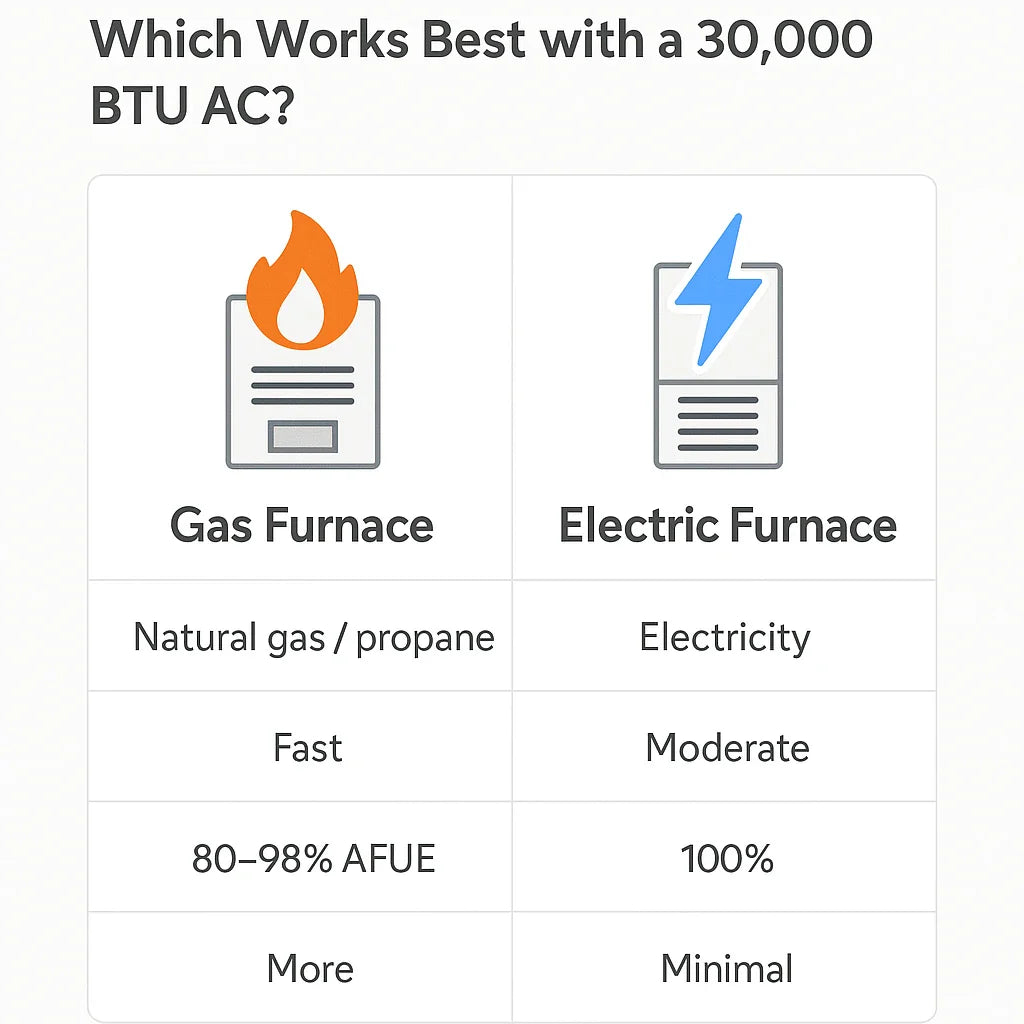When you’re shopping for a 30,000 BTU furnace and air conditioner combo, one of the first big questions is:
Should I go with a gas furnace or an electric furnace?
It’s not just about the type of fuel—it’s about climate, budget, comfort, and how your home is set up.
I’m Jake, and I’ve helped dozens of homeowners (and done a few installs myself) make this decision. In some cases, the choice was obvious. In others, we had to dig deep into the numbers and the way they live in their homes to find the right match.
Let’s break it down so you can make the best choice for your situation.
1. Why Furnace Type Matters with a 30,000 BTU AC
Pairing the right furnace with your AC isn’t just about keeping warm—it impacts:
-
Energy bills in the long run.
-
Comfort in different seasons.
-
System lifespan and maintenance costs.
Think of your AC and furnace as teammates. If one is mismatched to your home or climate, the whole system suffers.
2. How Gas & Electric Furnaces Work
Gas Furnace Basics
-
Burns natural gas or propane to heat air.
-
Heats up fast, so you feel warm quickly.
-
Requires venting for combustion gases.
-
Efficiency is measured in AFUE (Annual Fuel Utilization Efficiency). High-efficiency units can reach 98% AFUE.
Electric Furnace Basics
-
Uses electric resistance heating elements (like giant toaster coils).
-
100% efficient at converting electricity to heat, but electricity can cost more per BTU.
-
No venting required—simpler install in some homes.
-
Often quieter because there’s no combustion.
Quick Comparison Table:
| Feature | Gas Furnace | Electric Furnace |
|---|---|---|
| Fuel Source | Natural gas / propane | Electricity |
| Heat Speed | Fast | Moderate |
| Efficiency | 80–98% AFUE | 100% |
| Maintenance | More (burners, venting) | Minimal |
| Install Complexity | Higher | Lower |
3. Climate Considerations: Jake’s Rule of Thumb
Climate plays the biggest role in which furnace type makes sense.
Cold climates (Zones 5–7)
-
Winters are long and frigid.
-
Gas tends to be more cost-effective because natural gas is cheaper per unit of heat.
-
Example: Northern Midwest, New England.
Mild or warm climates (Zones 1–4)
-
Winters are short and mild.
-
Electric can be more affordable overall because it avoids gas hookup costs and complex venting.
-
Example: Southeast, coastal California.
Jake’s Tip: If your heating season is longer than your cooling season, lean toward gas. If cooling dominates, electric can make more sense.
4. Energy Efficiency & Operating Costs
The right choice also comes down to your local energy rates.
Gas Furnace:
-
Natural gas is often 2–3 times cheaper per BTU than electricity in cold climates.
-
High-efficiency models reduce waste heat.
-
In some regions, propane is the alternative—often pricier than gas but still cheaper than electric in winter.
Electric Furnace:
-
Always 100% efficient, but kWh costs can be high.
-
Can be cost-effective in areas with low electric rates or short heating seasons.
-
No flue heat loss.
Example Cost Comparison (1,000 sq. ft. home)
| Location | Gas Furnace Annual Cost | Electric Furnace Annual Cost |
|---|---|---|
| Michigan | ~$650 | ~$1,050 |
| Georgia | ~$300 | ~$320 |
These numbers assume average insulation, typical winters, and average energy prices in early 2025.
5. Installation Costs & Requirements
Gas Furnace Install:
-
Needs venting (chimney or PVC pipe).
-
Requires a gas line hookup.
-
More parts to install = slightly higher labor cost.
Electric Furnace Install:
-
Needs a high-capacity electrical circuit.
-
No venting or gas lines.
-
Often faster and less expensive to install if electrical capacity already exists.
Average Installed Cost with 30k BTU AC (2025):
-
Gas Furnace Pairing: $5,500–$8,000
-
Electric Furnace Pairing: $5,000–$7,500
6. Maintenance & Longevity
Gas Furnace:
-
Annual combustion inspection and cleaning.
-
Keep burners and heat exchanger in good shape to avoid dangerous CO leaks.
-
Typical lifespan: 15–20 years.
Electric Furnace:
-
Very little annual maintenance.
-
Just keep elements dust-free and blower clean.
-
Typical lifespan: 20–25 years.
Jake’s note: I’ve seen electric furnaces last 30 years with minimal fuss—but their running costs killed the savings in a cold climate.
7. Comfort & Performance
-
Gas furnaces heat air fast and deliver hotter supply temps—great for cold mornings.
-
Electric furnaces heat more steadily, but supply air is cooler—may feel less “toasty” in winter.
8. Environmental Impact
-
Gas: Fossil fuel use, but high-efficiency models reduce emissions per BTU.
-
Electric: Can be zero-emission if powered by solar or a clean grid—but may be worse if grid electricity is coal-heavy.
9. When to Choose Gas with Your 30,000 BTU AC
-
You live in cold climate zones.
-
You have affordable natural gas rates.
-
You already have a gas line in place.
-
You value fast, high-temperature heat.
10. When to Choose Electric with Your 30,000 BTU AC
-
You live in mild climates.
-
No existing gas line (avoids install cost).
-
You want simpler maintenance and quieter operation.
-
You have access to low-cost electricity or solar.
11. Jake’s Decision Checklist
-
Check your climate zone.
-
Compare local gas vs. electric rates.
-
Look at installation complexity for your home.
-
Decide if you want fast heat or steady heat.
-
Factor in maintenance comfort level.
12. Conclusion
If you live in northern states or run your heat for more than half the year, a gas furnace pairing with your 30,000 BTU AC will probably keep you warmer and save you money.
If you live in a southern or coastal region and heating is just a short seasonal need, an electric furnace pairing might be more affordable upfront and simpler to maintain.
Related Reading:
In the next article we will know more about: Energy Efficiency & SEER2 Ratings: What to Expect from 30k BTU Combo Units







